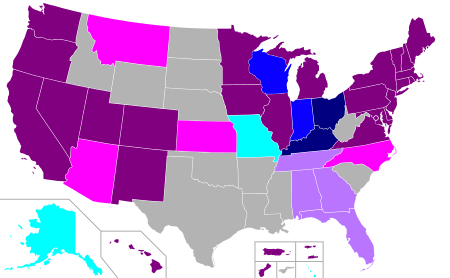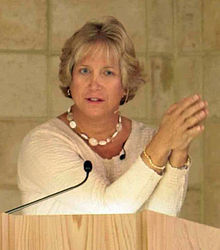Gender in public administration
This article is written like a personal reflection, personal essay, or argumentative essay that states a Wikipedia editor's personal feelings or presents an original argument about a topic. (May 2015) |
Gender has historically played an important role in public administration. Gender perception and other factors influence the ways in which people think about public administration and bureaucracy. In today's society, public administration remains widely segregated in regard to gender, though it has become commonplace to advocate for greater numbers of equality and non-discrimination policies.
Overview
During the early years of public administration, textbooks and curriculum largely overlooked
In 1864 the U.S. Government declared that when women were employed by the government, they should be paid one half of the salary that a man would be paid to perform exactly the same job. Though
History of patrimony in public administration
Gender norms and the shaping of public administration

When examining the role of gender in public administration, there are frequently two competing schools of thought: the "feminine" approach centers on social justice issues, while the "masculine" approach emphasizes efficiency and impartiality. These methods were employed harmoniously prior to World War I, with men and women cooperating to "emphasize the principles of classical pragmatism [and focus] on the efficient execution of policy but also on societal cooperation and the strengthening of public knowledge." After the outbreak of the war however, a shift in American public administration occurred. As the public administration system became more reliant on male-dominated organizations such as the
In addition to the increased reliance on masculine principles, American society's approach to social science began to change and thus influenced public admin. For example, in the late 1890s economists altered the way they studied by focusing less on general trends and more on statistics and hard facts. Sociology, on the other hand, remained focused "on a specialized knowledge based on the value-neutral pursuit of abstract generalizations about human relations" and continued to promote social justice. This dichotomy is largely responsible for the relegation of women to "more congenial specialties such as social work" while men remained leaders in finance and other scientifically driven organizations.[3]
Human capital theory
People who ascribe themselves to human capital theory have a different explanation of the differing representations of men and women in public administration and workplaces in general. Where some scholars have argued that men and women's roles in government come from a historic separation based on the opposition of "
The sociopsychological theory

Following the rise of human capital theory, and in response to many of its criticisms, researchers and sociologists developed the sociopsychological theory. This theory, like human capital theory before it, attributes a great deal of emphasis on the differing qualifications between men and women. What this theory does differently however, is give attention to the sociological constructs that inhibit women's inability to acquire equal qualifications. For example, these theorists argue that where men are typically attributed with social characteristics such as, "aggressiveness, ambition, and self-confidence," women have been deemed "affectionate, kind, sensitive, and soft-spoken" and are therefore like to be regarded by an employer as inferior to a man with the same qualifications. Sociopsychological theorists go on to argue that because of these differences, it is difficult for a woman to enter a profession heavily dominated by men because they are likely to be viewed as incompetent or less competent than their male counterparts. It has been argued that this fear of incompetency has led women to embrace more
In addition to predictions about the effects of personality traits on the role of women in the workforce, sociopsychological theorists argue that women's representation is largely due to the role of sociological stereotypes and
Benefits of gender diversity in public administration
Gender and diversity are necessary themes in public administration. They remind the field to embrace otherness and to comprehend the effect it has on policies, programs, and outcomes. In recent decades attention to the difference that differentness makes has spurred appreciation for divergent perspectives on, and interpretations of, public service. This is imperative if the discipline is to strive for the normative ideal of democratic governance.[5]
Public administration was first established as a matter of technical implementation where the values of efficiency and effectiveness were paramount. This upside down priority meant that the principles of social equity, protection of minority rights, and
Marginalized gender identities in public administration
- Women, trans and non-binary folks, etc.
There has been a striking increase in the proportion of MPA students and public administration faculty who are women, perhaps a result of the increase in both supply and demand for gender-related scholarship, or, alternatively, due to the increase in female public administrators. Yet many of the systems that persist in the workplace were built for people who do not get pregnant, who have no need for nursing rooms at the office, no need for maternity leave or early afternoon hours in order to pick children up after school, and have no need for eldercare and childcare responsibilities.[5]
Statistics of marginalized demographics in public administration
- History of marginalized presence in public administration—Currently, gender, religion, sexuality, representative bureaucracy, and ethnicity, are on the rise. Writings on sexuality are on the increase as more articles appear on the subject of same sex marriage, workplace benefits, and issues surrounding transgender nondiscrimination policy.[5]
International case studies: marginalized gender identities in public administration
Spanish municipalities
Upon investigating the gender make-up of 155 Spanish municipalities, researchers discovered that most departments in
Challenges for marginalized gender identities in public admin
- Social/cultural barriers
- Economic barriers
- National and global scale of barriers
Policies for increased gender representation in public administration
Policies that are currently active in the United States that aim to increase minority representation in public offices, places and of commerce have become more prevalent in the current political atmosphere.
| State Non-Discrimination Policies | Employment Non-Discrimination Act (pending):
 Sexual orientation and gender identity: all employment Sexual orientation with anti–employment discrimination ordinance and gender identity solely in public employment Sexual orientation: all employment Sexual orientation and gender identity: state employment Sexual orientation: state employment No state-level protection for LGBT employees |
| Federal Non-Discrimination Policies | Title VII of the Civil Rights Act of 1964:
|
| Equal Rights Ordinances | Houston Equal Rights Ordinance (HERO):
|
- Movements (i.e. grassroots movements) for more representation policies
Notable figures of marginalized identities in public administration
Mary Anderson

During the late 19th century and early 20th century, a movement involving the advocacy of social justice feminism began in the United States under Florence Kelley. It was during this time that many women entered the public sphere as they called for greater women's labor legislation and equality. One of these women, Mary Anderson, achieved great report in public administration through her continued efforts to create and encourage equality in government and in bureaucracy.[citation needed]
Though she immigrated to the United States from Sweden in the mid-1880s, Mary Anderson established a reputation amongst Samuel Gompers and other famous members of the labor movement by the 1910s. Anderson's role in the movement involved the drafting of an important management-labor agreement following a prominent garment worker's strike in 1911. Propelling herself forward from this success amongst labor advocates, Anderson was able to create an "extensive lobbying campaign" to include a women's division in the United States Department of Labor. Despite being unsuccessful in her lobbying endeavors, Anderson's notability granted her the position of head of the Women's Bureau when it was established as a permanent organization following the passage of the 20th amendment in 1920.[3]
Susan Stanton

Susan Ashley Stanton is a
References
- ^ "United States Census Bureau." 2007 Data Release – Data & Documentation – American Community Survey – U.S. Census Bureau. N.p., n.d. Web. April 22, 2015.
- ISSN 0033-3352.
- ^ .
- ^ S2CID 147098514.
- ^ a b c d Guy, Mary E.; Schumacher, Kristin (2009). "Gender and Diversity in Public Administration" (PDF). University of Colorado Denver. Retrieved July 8, 2015.
- .
- ^ Batista Medina, José Antonio (2015). "Public Administrations As Gendered Organizations. The Case Of Spanish Municipalities". Revista Española de Investigaciones Sociologicas. 149: 3–29.
- ^ "Employment Non-Discrimination Act". Human Rights Campaign. Retrieved April 24, 2015.
- ^ "Laws Enforced by the EEOC". US Equal Employment Opportunity Commission. EEOC. Retrieved April 24, 2015.
- ^ Morris, Mike. "Council Passes Equal Rights Ordinance" Houston Chronicle. May 28, 2014. Web. April 22, 2015
Further reading
- Bayes, J. H. (1991). "Women in public administration in the United States". Women & Politics. 11 (4): 85–109. ProQuest 213891805.
- Bayes, J. H. (1991). "Women and public administration: A comparative perspective- conclusion". Women & Politics. 11 (4): 111–131. ProQuest 213901740.
- Harris, J. W. (1994). "Introductory public administration textbooks: Integrating scholarship on women". Women & Politics. 14 (1): 83–101. ProQuest 213902164.
- Stivers, C (1990). "Toward a feminist perspective in public administration theory". Women & Politics. 10 (4): 49–65. ProQuest 213892261.
- Hinojosa, Magda; Sahir-Rosenfield, Sarah (2014). "Does Female Incumbency Reduce Gender Bias in Elections? Evidence from Chile". Political Research Quarterly. 67 (4): 4. S2CID 153365228.
- Black, Jerome H.; Erickson, Lynda (2003). "Women Candidates and Voter Bias: Do Women Politicians Need to Be Better?". Electoral Studies. 22: 81–100. .
- Carpinella, Colleen; Johnson, Kerri (2013). "Politics of the Face: The Role of Sex-Typicality In Trait Assessments of Politicians". Social Cognition. 31 (6): 6. .
- Johns, R.; Shepard, M. (2007). "Gender, candidate image and electoral preference". British Journal of Politics and International Relations. 9 (3): 434–460. S2CID 144866803.
- Lenz, G. S.; Lawson, C. (2011). "Looking the part: Television leads less informed citizens to vote based on candidates' appearance" (PDF). American Journal of Political Science. 55 (3): 574–589. hdl:1721.1/96161.
- Stivers, Camilla. Gender Images In Public Administration : Legitimacy And The Administrative State / Camilla Stivers. n.p.: Thousand Oaks : Sage Publications, [2002], 2002. Texas State - Alkek Library's Catalog. Web. March 8, 2015.
- Park, Sanghee (2013). "Does Gender Matter? The Effect Of Gender Representation Of Public Bureaucracy On Governmental Performance". American Review of Public Administration. 43 (2): 221–242. S2CID 154936915.
- Hutchinson, Janet R.; Mann, Hollie S. (2006). "Gender Anarchy And The Future Of Feminisms In Public Administration". Administrative Theory & Praxis. 28 (3): 399–417. S2CID 147421551.
- Riccucci, Norma M.; Van Ryzin, Gregg G.; Lavena, Cecilia F. (2014). "Representative Bureaucracy in Policing: Does It Increase Perceived Legitimacy?". J Public Adm Res Theory. 24 (3): 537–551. .
